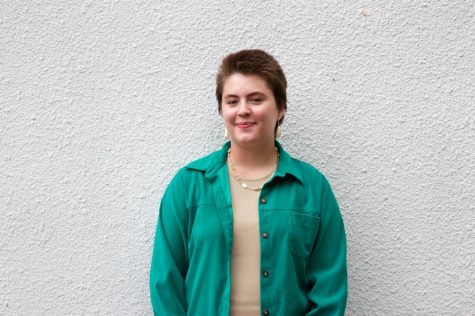When empathy and education collide
UW-Eau Claire Fine Arts Department collaborates with Mayo Clinic to educate on empathy
Photo by Submitted
The “Science of Empathy” discussion was held on Tuesday, Feb. 25. in the Davies center on campus. This event brought together practitioners from the Mayo Clinic of Eau Claire and professors from the Fine Arts department to share stories of empathy.
“My role is not to cure, but to care.”
An excerpt from a poem by Todd Wright, an orthopedic surgeon at the Mayo Clinic in Eau Claire, wrote it to showcase his deep connection to his profession and patients.
Practitioners within the Eau Claire medical professions are evolving beyond their practice of health, as the “Science of Empathy” project emerges among university students and individuals within the field they pursue.
Jyl Kelley, a professor through the UW-Eau Claire Department of Art and Design and collaborator on the “Science of Empathy” project, said her department had asked to collaborate with clinic practitioners to bring the two professions together.
“They were interested in photography because I think a number of the practitioners are photographers and enjoy that medium of working,” Kelley said. “We thought a lot about the importance of empathy — both here on campus as well as at the Mayo Clinic — and thought of ways that we could introduce it into an assignment in a class.”
This collaboration was brought to life through the “Science of Empathy” discussion on Tuesday, Feb. 25. in the Davies Student Center.
This event brought together practitioners from the Mayo Clinic of Eau Claire and professors from the fine arts department to share stories of empathy within the two fields.
The Mayo Clinic speakers included Wright, Wendy Sheasby, a licensed psychotherapist and James Deming, a physician through Mayo.
Cheryl Lapp, a professor in the UW-Eau Claire school of nursing, said she is pleased with the collaborative efforts the Mayo Clinic presents for the university learning programs.
Lapp said she has worked alongside the Mayo Clinic previously and values those within the medical field who introduce empathy as a useful tool within the field.
“The Mayo Clinic Health System is very progressive in terms of: they have also determined that there is a need for (empathy),” Lapp said. “They have a program called ‘Connecting with Empathy’ where they have an empathy trainer and she actually is training everybody — doctors, nurses, receptionists — who check-in patients. In the whole system they really value empathy.”
The event showcased Wright’s passion for poetry throughout his medical career. As he shared his personal stories of grievances, he attempted to make the unknown visible by connecting with patients.
Kelley said it was encouraging to see a large number of students who attended the event on campus and hear the stories of those directly within the medical field.
“It made the students wake up and think, ‘This is real.’ Someone was really sharing something about their life and they trust you enough to listen,” Kelley said. “I believe when I talked to some of the students afterwards, they were really moved by that.”
Throughout the university, approaches to empathy are being made throughout the arts department and the medical departments, including nursing.
Lapp said the concept of empathy was first introduced to her through journals and literature about empathetic decline experienced by medical students.
Lapp has created an honors course through the university titled “Empathy Enhancement for Helping Professions” to address the decline of empathy throughout both medical professions and those within communication-based professions.
“It declines from the time that they enter their programs — from when they are all idealistic and wanting to help people,” Lapp said. “I decided as an educator that I really need to take a look at this — to see how we socialize people — so that they are becoming less empathetic as time goes on.”
As the UW-Eau Claire Fine Arts Department continues to explore empathy, students within Kelley’s Digital and Advanced Studio Photography courses will create tableaus to represent the stories their portraits share.
The photographs will be in collaboration with the Mayo Clinic as they work on a gallery to showcase the works later this spring, according to the “Science of Empathy” event.
Kelley said she wants to emphasize how the theme of empathy will resonate differently with each student and even herself.
“Empathy is about understanding someone else and being sincere with them. I think it is about learning how to look,” Kelley said. “Look at something that is bigger than you — learning to look at a situation from a new perspective.”
Throughout her course curriculum, Lapp said she utilizes artistic exercises to introduce the importance of art to her students.
In her previous years of teaching and utilizing artists within the classroom, Lapp said she has been surprised to see the variety of interpretations students showcase through finding their own artistic vision.
“It really is surprising what students can find in art. What they see that sometimes — the person who chose it — does not expect them to see,” Lapp said. “Other times (the art) really communicates very clearly to something that the other person can connect to.”
According to Wright, the Mayo Clinic will be incorporating their own “Healing Arts Project” to highlight the connection between the arts and medical world.
The clinic has proposed five projects within the “Healing Arts Project” to include writers workshops, improv sessions, a new StoryCare project, fiber or textile arts and photography, according to the “Science of Empathy” event.
Lapp said through her experiences in the medical field, doctors or nurses can often lose sight of the patient they work alongside and their qualities as a human being. Rather, they begin to view patients as data statistics.
“You have a lot of material and you have to focus on and when presented with a patient problem, you are more likely to try and slot it into a stereotype or a diagnosis,” Lapp said. “It is like a premature assumption. Often they check on the chart data without getting to know the actual person.”
The photography category within the “Healing Arts Project” hopes to revolve around the education shield — within their “3 Shields” set of values, according to Mayo Clinic.
Kelley said she hopes to continue the expansion of the “Science of Empathy” project; yet, she is open to all possibilities of what the project could shape into.
“I am going to be trying to learn as much as I can from this project and see where it takes me,” Kelley said. “If you’re open to learning about what the possibilities could be, you will probably learn more than one thing. Moving forward, we’re going to know a lot more about how to plan the next (project) — and hopefully there will be a next one.”
Lapp said at the end of the day she loves to explore with students. She loves to engage with the student body on how to best begin conversations about empathy — within the medical field and beyond.
“It is very important to keep our students aware that they are dealing with human beings,” Lapp said. “That they really do have a role in helping people to feel that they have a voice by being supportive.”
Wright said his profession resonates with him through the people he heals and his ability to share their stories with others through art and poetry.
“Together, forever in a moment, love will see us through,” Wright wrote in a poem dedicated to his personal story of health.
For more information on the “Science of Empathy” project, contact Jyl Kelley or the Mayo Health Clinic in Eau Claire.
Nelson can be reached at nelsoner1654@uwec.edu.

Evelyn Nelson is a third-year Journalism and Environment, Society and Culture student. This is her fifth semester on The Spectator. She enjoys fulfilling her dream of being a barista, at SHIFT Cyclery and Coffee Bar. Stop by for some great coffee and conversation!

